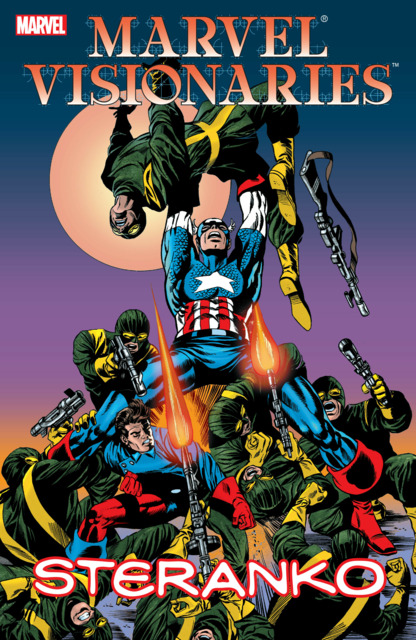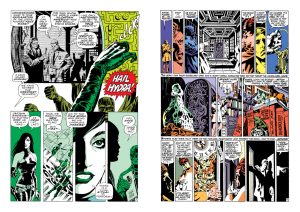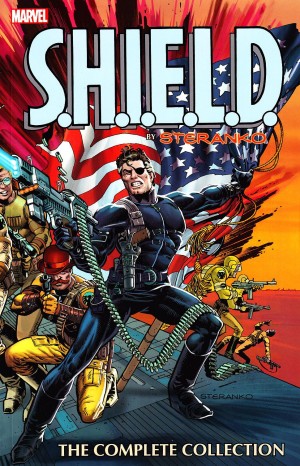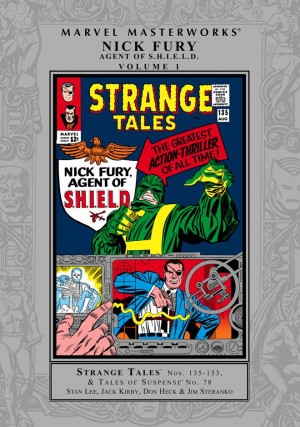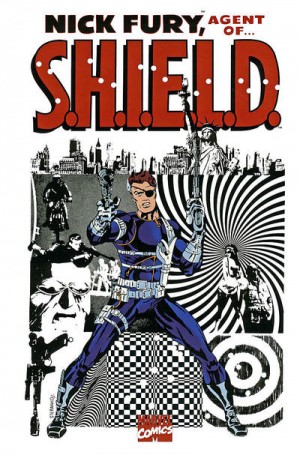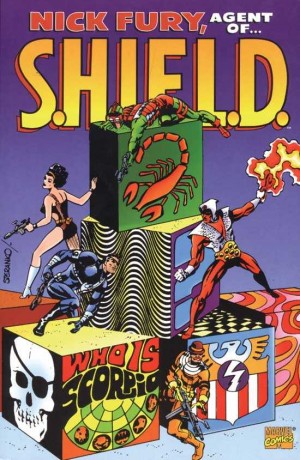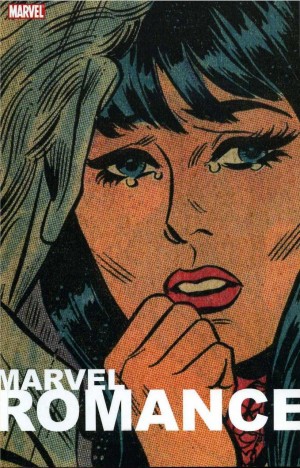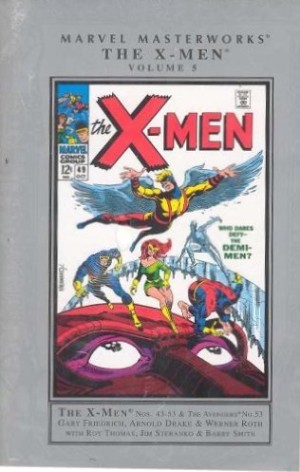Review by Graham Johnstone
Jim Steranko’s three years at Marvel, earned him a Marvel Visionaries single creator collection, three decades later.
He debuted in 1966 on the company’s Nick Fury: Agent of Shield. Initially working from layouts by Jack Kirby, by the following year he was not only pencilling, but inking, colouring and writing the series. He matched Kirby’s storytelling and dynamism, but added elegance, innovative page designs, fine art influences and 1960s cool.
A sampling of Nick Fury material would have been a welcome addition to this slim book. However, that has been collected in various editions. So Marvel have instead gathered Steranko’s handful of other stories for the company: two episodes of X-Men, three of Captain America, and one short each from romance and horror anthologies.
Given Steranko’s rapid development, it makes sense to have material presented in chronological order. His X-Men starts well, with a beautifully composed spread, and the story title artfully integrated into the background, but while layouts continue to be striking, inker John Tartaglione’s rough, textural style is mismatched to Steranko’s elegant precision. Someone may have been rushed, but this falls far short of the Sinnott/Palmer inked Captain America episodes from a few months later.
The usual downsides of a single artist collection are incomplete stories and varying writers. The X-Men episodes are from a longer storyline written by Arnold Drake. A monolithic story-so-far box, is followed by relentless plot explanation in leaden dialogue as Drake introduces Lorna Dane, later Polaris, but fails to maximise the inherent drama of her conflicting loyalties. Drake created Doom Patrol, DC’s band of outsider heroes, yet disappoints on their Marvel counterparts.
The writing of three classic Captain America episodes is attributed here to Marvel ringleader Stan Lee, though later officially credited to Steranko. They’re well-conceived, and sharply scripted, balancing pacy plots with poignant moments. Marvel’s itinerant sidekick, Rick Jones, triggers bittersweet memories of the Captain’s own fallen sidekick Bucky. This prompts a tentative partnership that’s immediately under attack by HYDRA (pictured, left). Thrilling action scenes are intercut with evocative set pieces: Cap in civvies passing his billboard image, mock publicity ‘photos’ of Cap and Bucky, and the Avengers as pall-bearers. Best of all is a news report on the missing-presumed-dead Captain. This unfolds in a series of monochrome TV screenshots, including remnants of his uniform, and a hand holding his bullet riddled cowl. The Sinnott/Palmer inks, and Steranko’s artful colouring contribute to a pinnacle of Marvel comics.
The Lovecraft-inspired ‘At the Stroke of Midnight’ led to tensions over Lee’s editing, but still won an Alley Award. It’s beautifully drawn, with characters navigating panoramic gothic backdrops, through rows of micro-panels (pictured, right) capturing moment-to-moment reactions. Steranko’s use of extreme tonal contrasts prefigures V for Vendetta and Sin City. It’s a visual delight, and not reprinted elsewhere.
His final short, ‘My Heart Broke In Hollywood’, draws on the romance and glamour of his S.H.I.E.L.D. stories. However, unlike Steranko’s empowered women there, schoolgirl Victoria swoons over a seasoned director. It would be gathering dust if not for Steranko’s stylish visual take on the genre. It’s beautifully rendered in delicate outlines, silhouettes, and candy colours, and he excels on contemporary fashions, and film paraphernalia. There’s even a swirling psychedelic montage, making it a great addition to Steranko’s comics oeuvre, and this collection.
The X-Men episodes retain flashes of brilliance, the genre shorts showcase Steranko’s restless versatility, and the Captain America sequence may be his finest work. Additional cover artwork further adds to a desirable collection, overdue a deluxe reissue.
